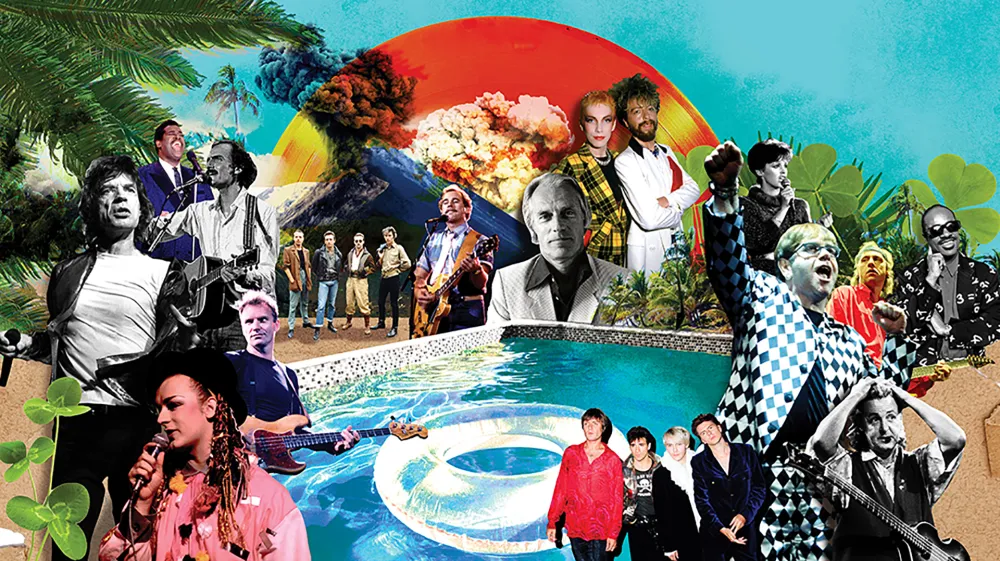
This Tiny Caribbean Island Was Beloved By ’80s Musicians. Now It’s Ready For A Comeback.
Mick Jagger, Stevie Wonder and Elton John all flocked to idyllic Montserrat to relax and record albums.
Related articles
The Caribbean island of Montserrat was a jet set getaway in the 1980s after music producer (and so-called ‘fifth Beatle’) Sir George Martin opened a recording studio there, AIR. The appeal of working with his team—and spending a few weeks or even months recording in a tropical paradise, too—was so compelling that the world’s most famous rockstars flocked there: Mick Jagger, Elton John, Stevie Wonder, and Paul McCartney all laid down tracks in Montserrat. The party ended abruptly when twin disasters struck the island, catastrophes from which it’s only just starting to recover. More than 25 years later, though, Montserrat is ready for a comeback.
Ebony and Ivory, Paul McCartney and Stevie Wonder Tug of War (1982)
When one of the Beatles arrived on the Caribbean island of Montserrat in 1981, he was mindful of security. Obviously—he was a Beatle. “Paul McCartney had bodyguards with cutlasses,” recalls local Cecil Wade, who now works as a guide and driver. “But he ended up giving them the money to go off somewhere else and just said, ‘Go ahead, enjoy yourselves.’ ” McCartney himself clearly planned to do much the same, installing his young family in a villa for several months while he worked; old pal Ringo Starr dropped in, making cameos in the home movies McCartney’s entourage shot then. His family, including daughter Stella, barely 10 then, frolic by the pool playing ping-pong, lark around on the balcony that overhangs it, and sit on the top of a cliff amid lush greenery.
The current owner of that villa, Providence Estate House, proudly points to one corner of the living room, which he has painstakingly renovated. Tony Glaser, an expat Briton who used to teach at the local university, notes there was once a piano where the bookcase sits. He indicates a framed colour photograph hanging on a nearby wall: McCartney and Stevie Wonder at that keyboard on the momentous visit when they recorded “Ebony and Ivory.”

McCartney came to Montserrat at the invitation of George Martin, the aristocratic, low-key producer nicknamed the Fifth Beatle. Martin had chanced upon the island in the late 1970s, when he was casting around for somewhere balmy to build another site for his studios, AIR. “George saw life in segments,” recalls David Lea, an expat American who knew the producer well and has lived here for decades. “First there was Abbey Road and the Beatles. Then AIR. Paul only came because of him.”
Give Me the Reason, Luther Vandross Give Me the Reason (1986)
McCartney wasn’t the only one. Name a chart-topping act, or an album, from the 1980s, and AIR Studios Montserrat will likely be part of the story: Elton John, Duran Duran, the Rolling Stones, Stevie Wonder, Earth Wind & Fire, James Taylor, Jimmy Buffett, Eurythmics, Boy George, and Sting all spent extended periods here. Martin, who died in 2016 at the age of 90, opened his state-of-the-art AIR Montserrat in 1979. He also bought a nearby home, Olveston House; it’s now run as a B&B and restaurant. For the studio, Martin converted an old water-storage facility on a hill into a place that the world’s premier rock stars would crave to come. It was named AIR, so the story went, as the recording room was built on ball bearings so it would float even when the supposedly dormant volcano that dominated Montserrat’s skyline would rumble, but, in fact, it’s an acronym for Associated Independent Recording.

There were guest rooms on-site where artists could stay, and a pool, too. Notoriously, many would use the roof as a diving platform, jumping off the top of the building into the deep end. “The real reason their albums turned out so good was that the studio had a pool,” recalls Danny Sweeney, a charmingly roguish surfing instructor who taught many musicians how to catch a wave. “It was a working vacation.”
The good times were not to last, as the rockstar playground of Montserrat was destroyed—not by fire and brimstone, but first by drenching rains, then by molten lava. Now, a quarter century after those twin catastrophes, the Caribbean island is making a comeback. This time, there’s no impresario to lure music’s biggest talents to the mountainous Eden, but the country is leaning into its singular place in rock history—as well as its own indigenous rocks and other natural beauty—to draw paradise seekers.
Walk of Life, Dire Straits Brothers in Arms (1985)
Today, Sweeney is rangy and flirtatious as he sits on the veranda of Olveston House. It’s easy, then, as he recounts a party almost 40 years ago, to picture him strutting around a dance floor for an entire evening, grabbing musicians’ wives and girlfriends to twirl until the early hours. He was always game to dance, but that particular night, he says, he never left the floor and was soaked with sweat when the nightclub closed. A few days later, Sweeney recalls, Mark Knopfler, the lead singer and guitarist of Dire Straits, called him into the studio while he played a snippet of a new song he’d written that Sweeney claims was inspired by his fleet-footing. “I used ‘Johnny’ instead of ‘Danny,’ in case you didn’t like being identified,” Knopfler told him. That tune was “Walk of Life.”
“I said to him, ‘Your album with this on it? It is going to sell 10 million copies or more,’ but he said the most he’d ever sold was 5 million,” Sweeney says now. “He promised to buy a new windsurfer if I was right.” He pauses, relishing the punch line to a story that he has clearly told many times before. “I am still waiting.” The album, Brothers in Arms, has sold more than 30 million copies worldwide, putting it comfortably in the top 50 best-selling albums of all time. Asked to comment for this story, Knopfler declined.
Turn It Into Something Good, Earth Wind & Fire Faces (1980)
Bassist Verdine White is a founding member of Earth Wind & Fire. He and his late brother, Maurice, the band’s front man, met George Martin during the filming of 1978’s flop movie adaptation of Sgt. Pepper’s Lonely Hearts Club Band. White tells Robb Report that he heard about the producer’s plans for AIR Montserrat then. “He invited us to come and record any time it was convenient for us, and it was perfect timing,” White says. “We chose to record our double LP Faces there, because it was a departure from what we had been doing. We needed to go back to basics, playing good tracks without trying to be commercial.”
White was smitten with Montserrat from the moment he arrived—mostly the friendliness of the locals. “The workers in the field dropped their tools and started applauding as we passed by,” he recalls. “As the only group of colour to record there, we were just honored and happy.” He emphasizes how the relaxed, welcoming vibe of the island was an ideal creative proving ground and how much the people there embraced the visiting musicians. “We didn’t get a chance to jam with the people, but the chef who prepared our meals was also a famous local DJ. He played our records during his time on the air and gave us tremendous shoutouts almost every day. We always listened to his show during mealtimes.”
I’m Still Standing, Elton John Too Low For Zero (1983)
James “Scriber” Daley, a local park ranger, has particularly fond memories of Elton John, who visited the island multiple times. “Lemme tell you, he would come hang out, and one Sunday, news got around he was in the village,” Daley recalls, noting that all the locals came down to say hello. Touched by the warm greeting, John told the bartender to put the entire afternoon’s tab on his check. (For John, Montserrat proved truly life-changing: He married AIR sound engineer Renate Blauel in 1984. They divorced four years later.)
Midge Ure of Ultravox fame loved Montserrat so much he bought a home here, though he’s reportedly called that purchase “the stupidest thing I did in the 1980s, because it was infested with termites.” Sting became smitten with the island, recording solo albums here after the Police split and renting a house for vacations with his wife and kids.

Not every rock star relished their time on Montserrat, though. One resident claims that Mick Jagger never seemed happy in Montserrat. “He hated it here, because nobody paid attention to him, so he’d walk back and forth to try and get noticed,” she says. But another disagrees, frowning. “Oh no, it wasn’t Mick. It was Duran Duran—they missed all the screaming girls.”
Looking at what remains of AIR now, though, one finds it hard to imagine those antics. There’s chain-link fencing across the driveway, featuring a KEEP OUT sign, erected by the Martin family. “We regret the need to restrict access… ,” it says, almost apologetically. The site’s a ruin, festooned with wasps’ nests, its windows glassless and what remains of the roofs askew. It was pummeled not once, but twice, by those disasters that struck the country three decades ago.
Calm Before the Storm, Sheena Easton Take My Time (1981)
Hurricane Hugo punched first. The 1989 storm passed right over the country, the first such direct hit in decades. The devastation was widespread. One local estimates that 95 percent of the houses here were left without a roof. As for AIR, that bunker-like building was built to survive. The thick concrete walls, essential for a soundproof studio, withstood the winds well. The problem was power: The on-site backup generator, a fail-safe during the island’s regular brownouts to ensure that no rock star’s riff ever went to waste, was broken. “Poor maintenance,” says one local, grumbling about the lapse.
In the wake of the power loss caused by the storm, both heat and moisture wreaked havoc at AIR. When Martin arrived to inspect the damage a few weeks later, Danny Sweeney recounts, the impresario opened the piano to look at the keys. The ivories were already covered in green mould. There was no money to restore the studio—or rather, no point. As the 1980s ended, record-company budgets were shrinking. With improved technology, corporate studios became obsolete, and the penny-pinchers saw little reason to underwrite a three-month stint in the sun for Paul McCartney, Dire Straits or anyone else. “I asked him if Hugo hadn’t hit, whether it would still be open,” says David Lea. “And George told me, ‘Oh no, never. Digital was taking over.’ ”
Rock and a Hard Place, Rolling Stones Steel Wheels (1989)
Perhaps, though, Martin might have found a way to reboot his enterprise—AIR still operates a site in the UK, after all—had a second disaster not struck just six years later. The locals had long learned in school that the volcano here, Soufrière Hills, which dominated the southwest centre of the pear-shaped country, was a dormant relic despite the occasional burping rumble. In 1995, those lessons were proved wrong. Rumblings continued for two years, until a major eruption in summer 1997. Nineteen people were killed, and two-thirds or so of Montserrat’s land—including all of its most fertile farmland, as well as the thriving capital, Plymouth—became uninhabitable, buried beneath ash and lava like a Caribbean Pompeii.

It’s possible now to visit what remains of Plymouth, albeit with a guide, and wander around the rubble-strewn roads. Three-story buildings sit, poking slightly out of the ground, their interiors full of once-molten lava. Entering the exclusion zone here—a no man’s land, a tropical DMZ—one notices the roads instantly become rougher, and the air starts to stink with sulfur. “When the eruption happened, it was so strong you had to hold your nose. It burned,” says guide Cecil Wade, standing in the centre of the former downtown. Now the only activity is the dusty thunder of trucks, which crisscross the land carrying sand mined from the volcanic ash—so much better for construction, as it’s salt-free, unlike a beachy supply. It’s commodity as apology, as if the volcano is trying to give back something after wrecking the locals’ lives.
The volcano is still considered active, and its seismic movement is closely tracked via an observation post manned by staff from the University of the West Indies. It’s deemed safe enough, however, for the authorities to open some sections on the northern edge of the exclusion zone to visitors to explore unaccompanied, including the area around AIR Studios, for example, or the once-tony district of Richmond Hill. Most of the homes there are half-hidden in the undergrowth, after 25 years of nature reclaiming the landscape. Occasionally, though, one shows through, gleamingly pristine—take the squat blue box, its window-sills painted egg-yolk yellow nestled amid the ruins. “They can’t go back,” says Scriber Daley of the owners of these sentimental but futile renovations, which still lack electricity and running water. “But psychologically, in their minds? They have it that they might one day. Sometimes people now go and lie down there, sleep and rest themselves for a while. Just to reminisce about the past.”
Living in the Past, Midge Ure The Gift (1985)
It was a ruinous disaster for a place with such a storied history. In the aftermath, Montserrat’s population was offered free passage, and passports, to live in the UK. Three-quarters of locals took one-way flights out. A hardy contingent remained, though. “I wasn’t tempted to leave,” recalls David Lea. “When the last ferry leaves, I’ll be on the one after that.” Instead, he salvaged what he could—one dial from the old Plymouth clocktower, for instance—and created a shrine to that era in memorabilia, ranged among the tables of his bar, the Hilltop Coffee House.
Modern Montserratians may now have British passports, but the first Europeans here were Irish, mostly indentured workers banished to the otherwise uninhabited island from the plantations on nearby St. Kitts after one too many rebellions. Their culture is palpable even now: In places with names such as Cork Hill or Galway, the shamrock on the welcome stamp in every passport and even the national dish—squint a little at a bowl of goat water and it could be Irish stew. St. Patrick’s Day is a national holiday on Montserrat, the only country other than Ireland proper. “We’re Afro-Irish,” adds Kenneth Silcott, a former champion calypso king who now runs the arts council. “At the St. Patrick’s feast, you’ll see some people in full green garb and others in African dress.”
Hot Hot Hot, Arrow Hot Hot Hot (1983)
Those Irish immigrants also brought music, which was a cherished part of the Montserratian life well before Martin and co. arrived. Their love for it commingled with the African traditions of the enslaved people who were shipped to the island to work on the sugar plantations. “Music for us is an integral part of our culture,” says Rose Willock, a longtime host at local radio station ZJB. Music here, she explains, combines Celtic and African traditions—the Oriole String Band, for instance, today plays a repertoire that ranges from soca to chanteys. Look closely at the carnival dancing, too, and you might recognize Irish toe-stepping in its movements.

Montserrat’s most famous homegrown musician, though, was Alphonsus Cassell, better known as Arrow. He and his brother wrote the worldwide smash “Hot Hot Hot” on the island, and Arrow carved out a path for a distinctive soca sound that incorporated merengue beats into its rhythmic fusion. Cody Greenwood was a regular visitor to Montserrat as a child and just 5 years old when the eruption happened; she produced the recent documentary Under the Volcano, about the AIR Studios era. “It was important for me to acknowledge local music in it—the soca, too. It’s been embedded in the culture forever, and Arrow is really the local hero down here, even now,” she says of the musician, who died in 2010. “The strong music culture meant when artists would come down, the locals would sing on a lot of the albums, like for Elton John or Dire Straits.”
Boat Drinks, Jimmy Buffett Volcano (1979)
Greenwood hoped that her film would pique viewers’ curiosity about Montserrat and tempt them to visit—she’d even intended to premiere it on the island with the goal of luring some of those rock-star icons to return for a nostalgic look. Pandemic lockdowns precluded any such celebrations. The local government does have concrete plans, though, to draw tourists. They’re centred on Little Bay, close to the northern tip of the island and near the country’s new commercial and political hub.

Little Bay became the emergency base for supplies after the eruption, but the waters here are too shallow for much commercial shipping or any superyacht. Dredging to rectify that problem has begun, and there’s a big patch of dusty scrubland on the waterfront ready for construction of a port that can harbor high-end cruise ships and private vessels by bolstering the jetty to 426 feet and the depth of waters from 9 to 26 feet. “Little Bay is one of the most sheltered harbors on the island,” explains Dion Weekes, the project manager. “And we want to have yachts calling there in 18 months.”
Spirits in the Material World, The Police Ghost in the Machine (1981)
Doubtless, many will come to make pilgrimages to AIR and Olveston House, a chance to connect with an overgrown corner of rock history. But there’s more to Montserrat than rubble. Much like neighbouring Dominica’s, the countryside here is lush and quilted with trails.
Scriber Daley—he earned his nickname at school, because he was such a good describer—is the ideal guide for exploring. Walking under the forest canopy with him is like accompanying Dr. Doolittle. He holds a thumb to his lips, sucking and tutting simultaneously like a scolding kiss. In response, the tree up ahead starts filling with Montserrat orioles, the national bird found only on the island; they twitter noisily in reply, more and more gathering to answer his calls.
Daley relishes the chance to take folks hiking for hours over Hope Ridge or Katy Hill, looking for birds or the Montserrat orchid. But one animal no one ever sees or hears now is a cricket he calls the spoon-in-glass. “It would go ting-ting-ting, and it was a sign to drop everything and leave the forest, because night could come over very fast,” he recalls. After decades of its silence, though, Daley fears this insect was wiped out in the wake of the eruption. “I have slept over there in the forest to see if I could hear the sound. It was so lovely. I never have.” He remains hopeful, though, and he doesn’t stop trying.
Despite the natural disasters’ upheaval, little about the island’s culture has changed. “My mum always used to say to me, ‘You don’t lock up here—no one will rob you,’ ” says Greenwood. “We had over a million dollars’ worth of camera equipment, and we could never find a key for our villa, but people just said, ‘You don’t have to worry.’ On Montserrat, you don’t have to worry about a thing.”
Subscribe to the Newsletter
Recommended for you
5 Lounge Chairs That Add Chic Seating to Your Space
Daybeds, the most relaxed of seating solutions, offer a surprising amount of utility.
July 22, 2024
Living La Vida Lagerfeld
The world remembers him for fashion. But as a new tome reveals, the iconoclastic designer is defined as much by extravagant, often fantastical, homes as he is clothes.
July 22, 2024
You may also like.
By Josh Bozin
24/07/2024
You may also like.
5 Lounge Chairs That Add Chic Seating to Your Space
Daybeds, the most relaxed of seating solutions, offer a surprising amount of utility.
Chaise longue, daybed, recamier, duchesse brisée—elongated furniture designed for relaxing has a roster of fancy names. While the French royal court of Louis XIV brought such pieces to prominence in fashionable European homes, the general idea has been around far longer: The Egyptian pharaohs were big fans, while daybeds from China’s Ming dynasty spurred all those Hollywood Regency fretwork pieces that still populate Palm Beach living rooms. Even Mies van der Rohe, one of design’s modernist icons, got into the lounge game with his Barcelona couch, a study of line and form that holds up today.
But don’t get caught up in who invented them, or what to call them. Instead, consider their versatility: Backless models are ideal in front of large expanses of glass (imagine lazing on one with an ocean view) or at the foot of a bed, while more structured pieces can transform any corner into a cozy reading nook. Daybeds may be inextricably linked to relaxation, but from a design perspective, they put in serious work.

Emmy, Egg Collective
In designing the Emmy chaise, the Egg Collective trio of Stephanie Beamer, Crystal Ellis and Hillary Petrie, who met as students at Washington University in St. Louis, aimed for versatility. Indeed, the tailored chaise looks equally at home in a glass skyscraper as it does in a turn-of-the-century town house. Combining the elegance of a smooth, solid oak or walnut frame with the comfort of bolsters and cushioned upholstery or leather, it works just as well against a wall or at the heart of a room. From around $7,015; Eggcollective.com
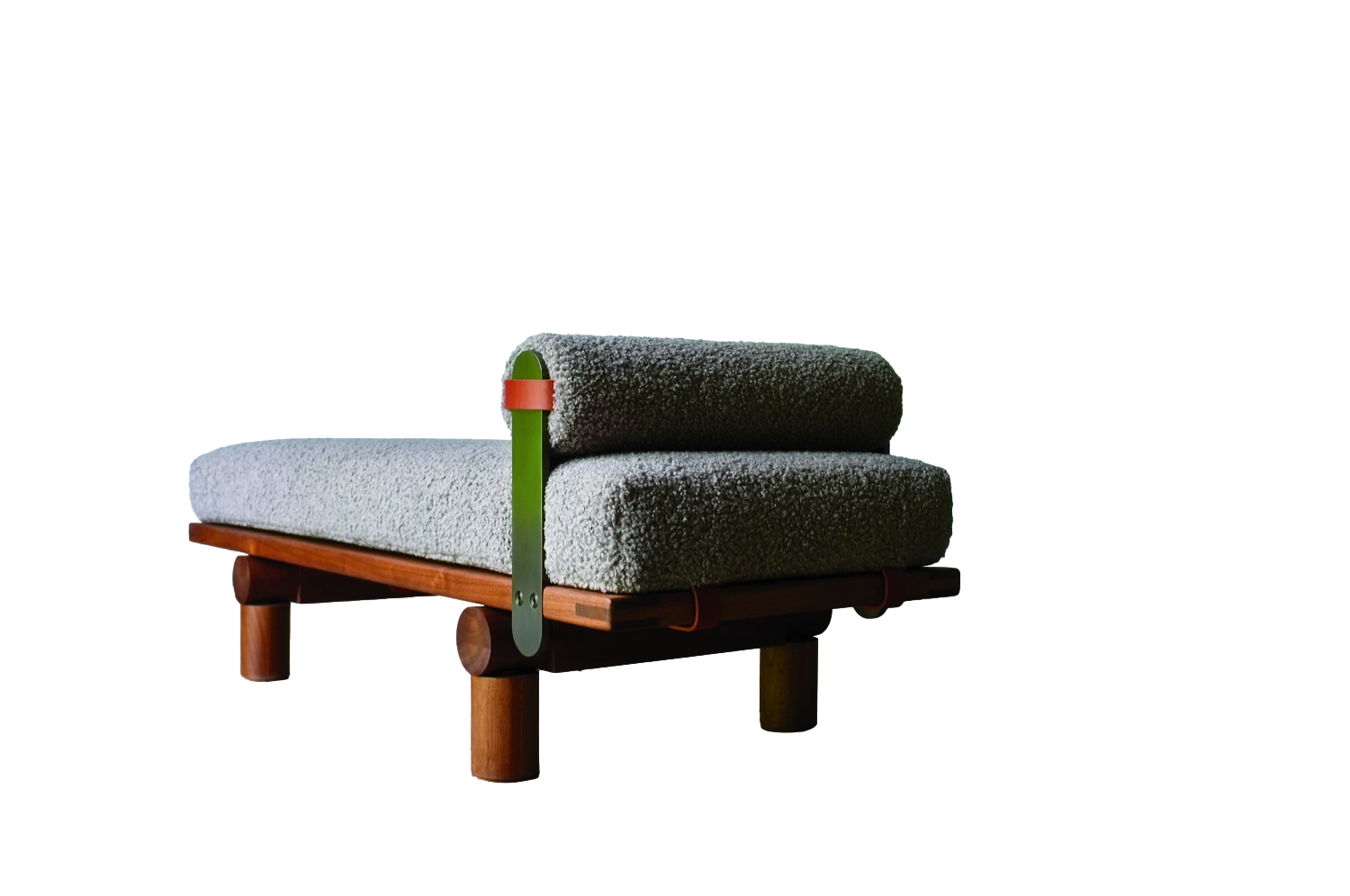 Plum, Michael Robbins
Plum, Michael Robbins
Woodworker Michael Robbins is the quintessential artisan from New York State’s Hudson Valley in that both his materials and methods pay homage to the area. In fact, he describes his style as “honest, playful, elegant and reflective of the aesthetic of the Hudson Valley surroundings”. Robbins crafts his furniture by hand but allows the wood he uses to help guide the look of a piece. (The studio offers eight standard finishes.) The Plum daybed, brought to life at Robbins’s workshop, exhibits his signature modern rusticity injected with a hint of whimsy thanks to the simplicity of its geometric forms. Around $4,275; MichaelRobbins.com
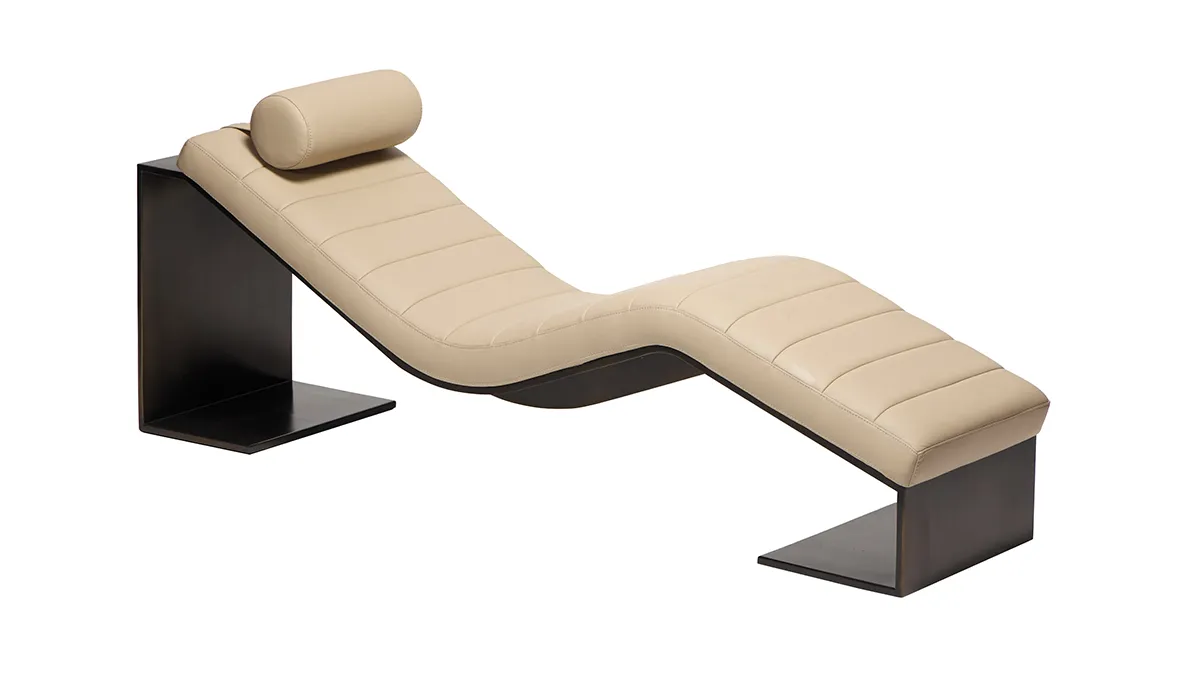
Kimani, Reda Amalou Design
French architect and designer Reda Amalou acknowledges the challenge of creating standout seating given the number of iconic 20th-century examples already in existence. Still, he persists—and prevails. The Kimani, a bent slash of a daybed in a limited edition of eight pieces, makes a forceful statement. Its leather cushion features a rolled headrest and rhythmic channel stitching reminiscent of that found on the seats of ’70s cars; visually, these elements anchor the slender silhouette atop a patinated bronze base with a sure-handed single line. The result: a seamless contour for the body. Around $33,530; RedaAmalou
Dune, Workshop/APD
From a firm known for crafting subtle but luxurious architecture and interiors, Workshop/APD’s debut furniture collection is on point. Among its offerings is the leather-wrapped Dune daybed. With classical and Art Deco influences, its cylindrical bolsters are a tactile celebration, and the peek of the curved satin-brass base makes for a sensual surprise. Associate principal Andrew Kline notes that the daybed adeptly bridges two seating areas in a roomy living space or can sit, bench-style, at the foot of a bed. From $13,040; Workshop/ APD
Sherazade, Edra
Designed by Francesco Binfaré, this sculptural, minimalist daybed—inspired by the rugs used by Eastern civilizations—allows for complete relaxation. Strength combined with comfort is the name of the game here. The Sherazade’s structure is made from light but sturdy honeycomb wood, while next-gen Gellyfoam and synthetic wadding aid repose. True to Edra’s amorphous design codes, it can switch configurations depending on the user’s mood or needs; for example, the accompanying extra pillows—one rectangular and one cylinder shaped— interchange to become armrests or backrests. From $32,900; Edra
You may also like.
By Josh Bozin
24/07/2024
22/07/2024
Watches & Wonders 2024 Showcase: Hermès
We head to Geneva for the Watches & Wonders exhibition; a week-long horological blockbuster featuring the hottest new drops, and no shortage of hype.
With Watches & Wonders 2024 well and truly behind us, we review some of the novelties Hermès presented at this year’s event.
—
HERMÈS
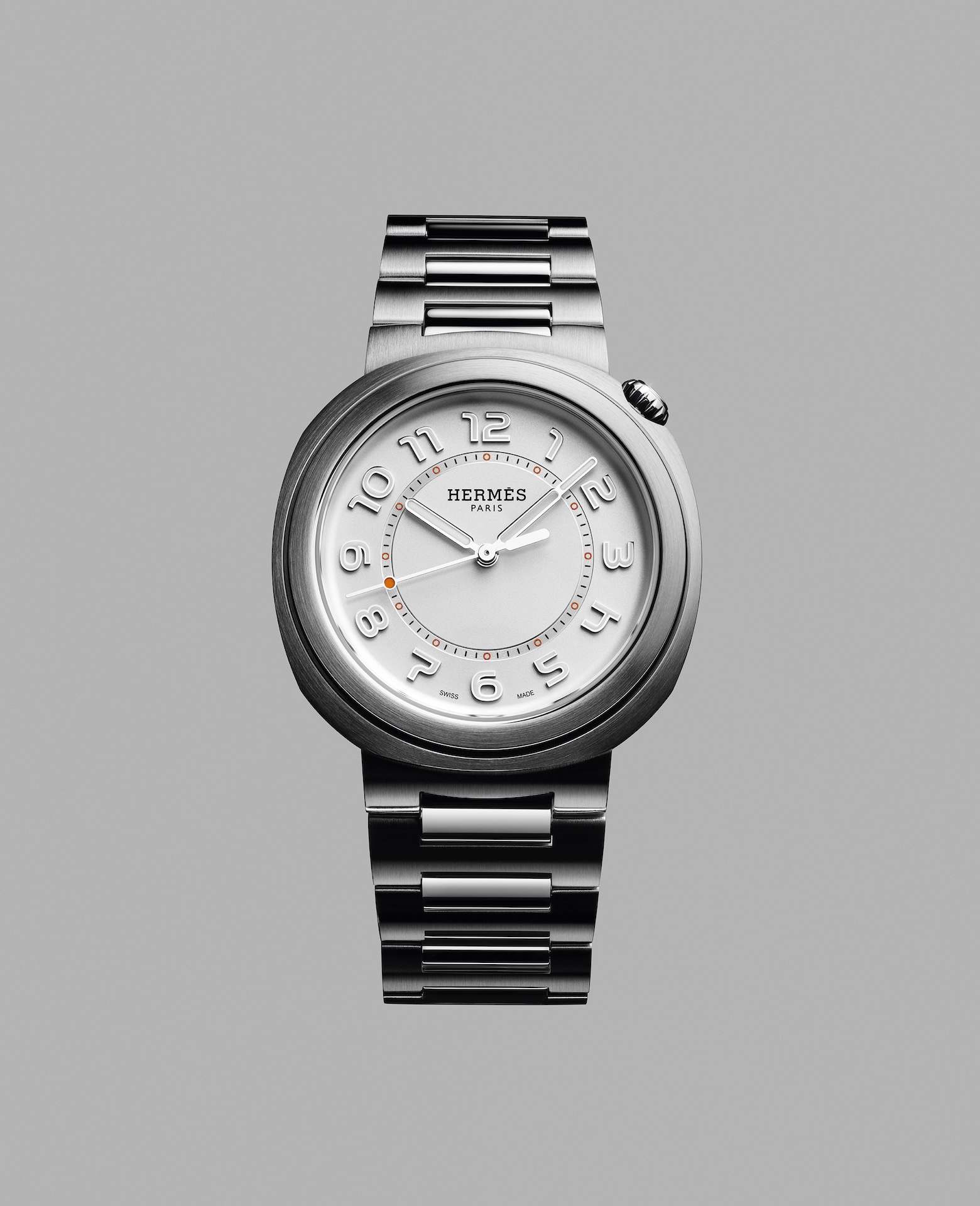
Moving away from the block colours and sporty aesthetic that has defined Hermès watches in recent years, the biggest news from the French luxury goods company at Watches & Wonders came with the unveiling of its newest collection, the Hermès Cut.
It flaunts a round bezel, but the case middle is nearer to a tonneau shape—a relatively simple design that, despite attracting flak from some watch aficionados, works. While marketed as a “women’s watch”, the Cut has universal appeal thanks to its elegant package and proportions. It moves away from the Maison’s penchant for a style-first product; it’s a watch that tells the time, not a fashion accessory with the ability to tell the time.
Hermès gets the proportions just right thanks to a satin-brushed and polished 36 mm case, PVD-treated Arabic numerals, and clean-cut edges that further accentuate its character. One of the key design elements is the positioning of the crown, boldly sitting at half-past one and embellished with a lacquered or engraved “H”, clearly stamping its originality. The watch is powered by a Hermès Manufacture movement H1912, revealed through its sapphire crystal caseback. In addition to its seamlessly integrated and easy-wearing metal bracelet, the Cut also comes with the option for a range of coloured rubber straps. Together with its clever interchangeable system, it’s a cinch to swap out its look.
It will be interesting to see how the Hermès Cut fares in coming months, particularly as it tries to establish its own identity separate from the more aggressive, but widely popular, Ho8 collection. Either way, the company is now a serious part of the dialogue around the concept of time.
—
Read more about this year’s Watches & Wonders exhibition at robbreport.com.au
You may also like.
22/07/2024
Living La Vida Lagerfeld
The world remembers him for fashion. But as a new tome reveals, the iconoclastic designer is defined as much by extravagant, often fantastical, homes as he is clothes.
“Lives, like novels, are made up of chapters”, the world-renowned bibliophile, Karl Lagerfeld, once observed.
Were a psychological-style novel ever to be written about Karl Lagerfeld’s life, it would no doubt give less narrative weight to the story of his reinvigoration of staid fashion houses like Chloe, Fendi and Chanel than to the underpinning leitmotif of the designer’s constant reinvention of himself.
In a lifetime spanning two centuries, Lagerfeld made and dropped an ever-changing parade of close friends, muses, collaborators and ambiguous lovers, as easily as he changed his clothes, his furniture… even his body. Each chapter of this book would be set against the backdrop of one of his series of apartments, houses and villas, whose often wildly divergent but always ultra-luxurious décor reflected the ever-evolving personas of this compulsively public but ultimately enigmatic man.
With the publication of Karl Lagerfeld: A Life in Houses these wildly disparate but always exquisite interiors are presented for the first time together as a chronological body of work. The book indeed serves as a kind of visual novel, documenting the domestic dreamscapes in which the iconic designer played out his many lives, while also making a strong case that Lagerfeld’s impact on contemporary interior design is just as important, if not more so, than his influence on fashion.

In fact, when the first Lagerfeld interior was featured in a 1968 spread for L’OEil magazine, the editorial describes him merely as a “stylist”. The photographs of the apartment in an 18th-century mansion on rue de Université, show walls lined with plum-coloured rice paper, or lacquered deepest chocolate brown in sharp contrast to crisp, white low ceilings that accentuated the horizontality that was fashionable among the extremely fashionable at the time. Yet amid this setting of aggressively au courant modernism, the anachronistic pops of Art Nouveau and Art Deco objects foreshadow the young Karl’s innate gift for creating strikingly original environments whose harmony is achieved through the deft interplay of contrasting styles and contexts.
Lagerfeld learned early on that presenting himself in a succession of gem-like domestic settings was good for crafting his image. But Lagerfeld’s houses not only provided him with publicity, they also gave him an excuse to indulge in his greatest passion. Shopping!
By 1973, Lagerfeld was living in a new apartment at Place Saint–Sulpice where his acquisition of important Art Deco treasures continued unabated. Now a bearded and muscular disco dandy, he could most often be found in the louche company of the models, starlets and assorted hedonistic beauties that gathered around the flamboyant fashion illustrator Antonio Lopez. Lagerfeld was also in the throes of a hopeless love affair with Jacques de Bascher whose favours he reluctantly shared with his nemesis Yves Saint Laurent.

He painted the rooms milky white and lined them with specially commissioned carpets—the tawny patterned striations of which invoked musky wild animal pelts. These lent a stark relief to the sleek, machine-age chrome lines of his Deco furnishings. To contemporary eyes it remains a strikingly original arrangement that subtly conveys the tensions at play in Lagerfeld’s own life: the cocaine fuelled orgies of his lover and friends, hosted in the pristine home of a man who claimed that “a bed is for one person”.
In 1975, a painful falling out with his beloved Jacques, who was descending into the abyss of addiction, saw almost his entire collection of peerless Art Deco furniture, paintings and objects put under the auctioneer’s hammer. This was the first of many auction sales, as he habitually shed the contents of his houses along with whatever incarnation of himself had lived there. Lagerfeld was dispassionate about parting with these precious goods. “It’s collecting that’s fun, not owning,” he said. And the reality for a collector on such a Renaissance scale, is that to continue buying, Lagerfeld had to sell.
Of all his residences, it was the 1977 purchase of Hôtel Pozzo di Borgo, a grand and beautifully preserved 18th-century house, that would finally allow him to fulfill his childhood fantasies of life in the court of Madame de Pompadour. And it was in this aura of Rococó splendour that the fashion designer began to affect, along with his tailored three-piece suits, a courtier’s ponytailed and powdered coif and a coquettish antique fan: marking the beginning of his transformation into a living, breathing global brand that even those with little interest in fashion would immediately recognise.
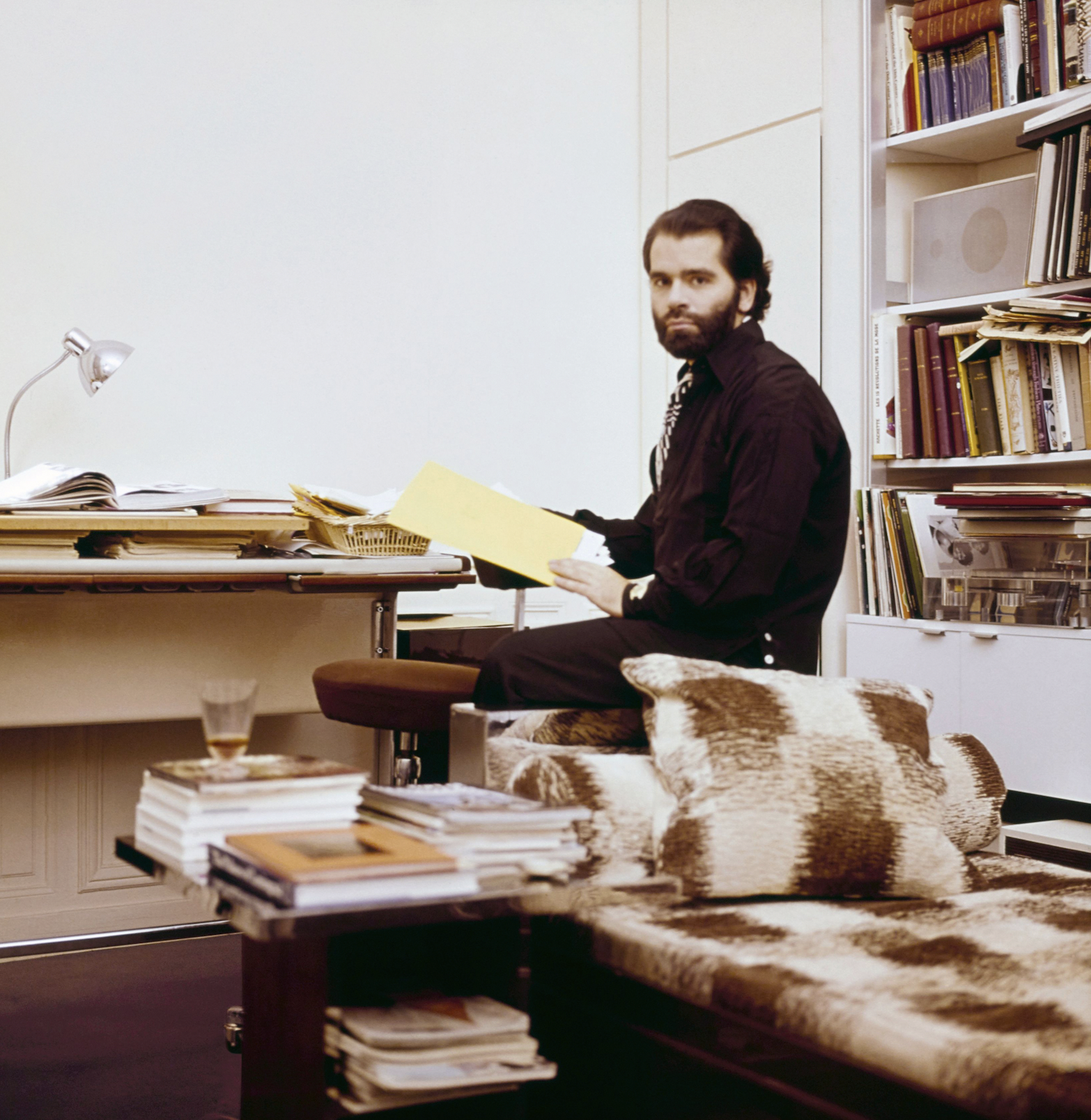
Lagerfeld’s increasing fame and financial success allowed him to indulge in an unprecedented spending frenzy, competing with deep-pocketed institutions like the Louvre to acquire the finest, most pedigreed pearls of the era—voluptuously carved and gilded bergères; ormolu chests; and fleshy, pastel-tinged Fragonard idylls—to adorn his urban palace. His one-time friend André Leon Talley described him in a contemporary article as suffering from “Versailles complex”.
However, in mid-1981, and in response to the election of left-wing president, François Mitterrand, Lagerfeld, with the assistance of his close friend Princess Caroline, became a resident of the tax haven of Monaco. He purchased two apartments on the 21st floor of Le Roccabella, a luxury residential block designed by Gio Ponti. One, in which he kept Jacques de Bascher, with whom he was now reconciled, was decorated in the strict, monochromatic Viennese Secessionist style that had long underpinned his aesthetic vocabulary; the other space, though, was something else entirely, cementing his notoriety as an iconoclastic tastemaker.
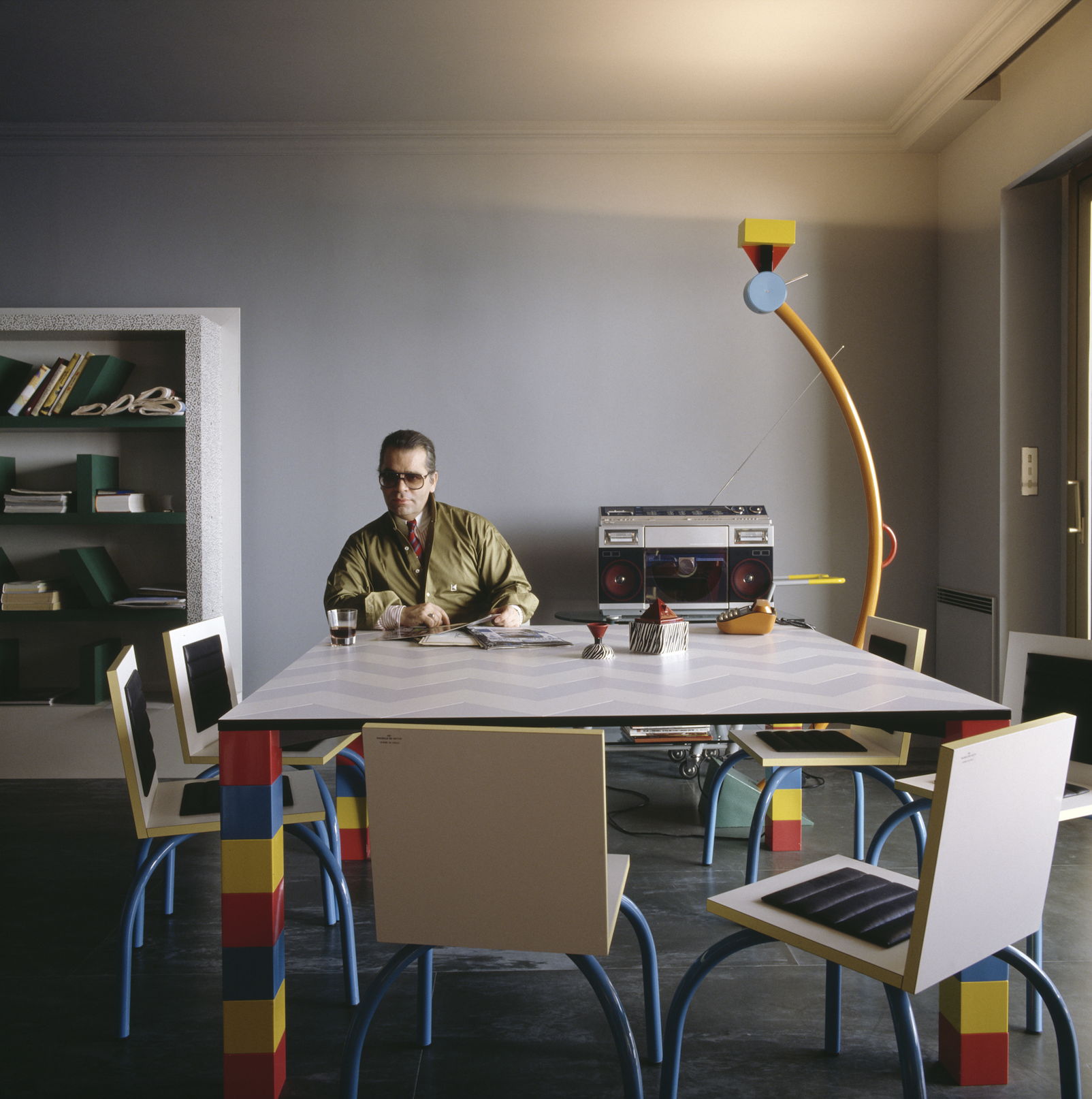
Lagerfeld had recently discovered the radically quirky designs of the Memphis Group led by Ettore Sottsass, and bought the collective’s entire first collection and had it shipped to Monaco. In a space with no right angles, these chaotically colourful, geometrically askew pieces—centred on Masanori Umeda’s famous boxing ring—gave visitors the disorientating sensation of having entered a corporeal comic strip. By 1991, the novelty of this jarring postmodern playhouse had inevitably worn thin and once again he sent it all to auction, later telling a journalist that “after a few years it was like living in an old Courrèges. Ha!”
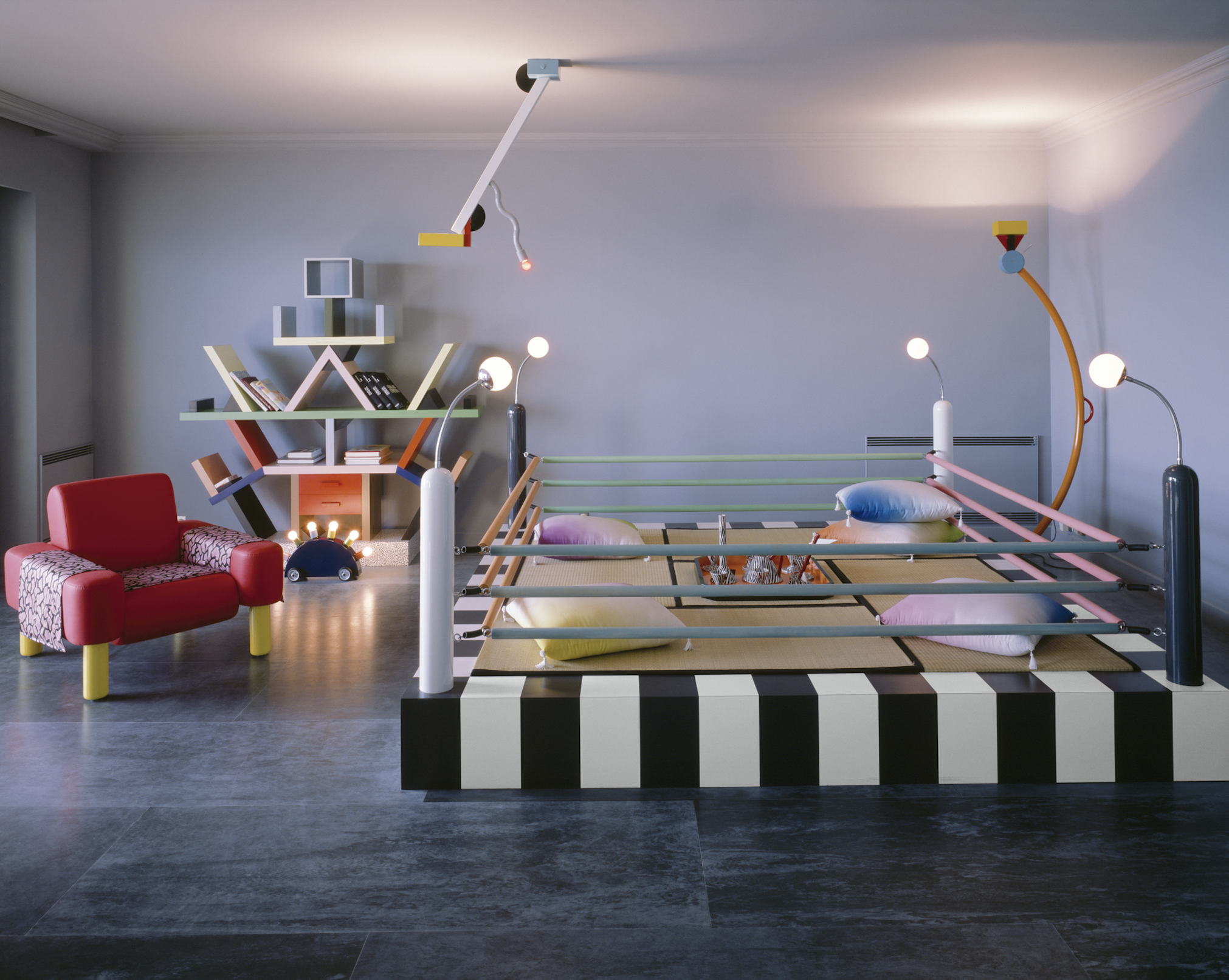
In 1989, de Bascher died of an AIDS-related illness, and while Lagerfeld’s career continued to flourish, emotionally the famously stoic designer was struggling. In 2000, a somewhat corpulent Lagerfeld officially ended his “let them eat cake” years at the Hôtel Pozzo di Borgo, selling its sumptuous antique fittings in a massive headline auction that stretched over three days. As always there were other houses, but now with his longtime companion dead, and his celebrity metastasising making him a target for the paparazzi, he began to look less for exhibition spaces and more for private sanctuaries where he could pursue his endless, often lonely, work.
His next significant house was Villa Jako, named for his lost companion and built in the 1920s in a nouveau riche area of Hamburg close to where he grew up. Lagerfeld shot the advertising campaign for Lagerfeld Jako there—a fragrance created in memorial to de Bascher. The house featured a collection of mainly Scandinavian antiques, marking the aesthetic cusp between Art Nouveau and Art Deco. One of its rooms Lagerfeld decorated based on his remembrances of his childhood nursery. Here, he locked himself away to work—tellingly—on a series of illustrations for the fairy tale, The Emperor’s New Clothes. Villa Jako was a house of deep nostalgia and mourning.
But there were more acts—and more houses—to come in Lagerfeld’s life yet. In November 2000, upon seeing the attenuated tailoring of Hedi Slimane, then head of menswear at Christian Dior, the 135 kg Lagerfeld embarked on a strict dietary regime. Over the next 13 months, he melted into a shadow of his former self. It is this incarnation of Lagerfeld—high white starched collars; Slimane’s skintight suits, and fingerless leather gloves revealing hands bedecked with heavy silver rings—that is immediately recognisable some five years after his death.
The 200-year-old apartment in Quái Voltaire, Paris, was purchased in 2006, and after years of slumber Lagerfeld—a newly awakened Hip Van Winkle—was ready to remake it into his last modernist masterpiece. He designed a unique daylight simulation system that meant the monochromatic space was completely without shadows—and without memory. The walls were frosted and smoked glass, the floors concrete and silicone; and any hint of texture was banned with only shiny, sleek pieces by Marc Newson, Martin Szekely and the Bouroullec Brothers permitted. Few guests were allowed into this monastic environment where Lagerfeld worked, drank endless cans of Diet Coke and communed with Choupette, his beloved Birman cat, and parts of his collection of 300,000 books—one of the largest private collections in the world.
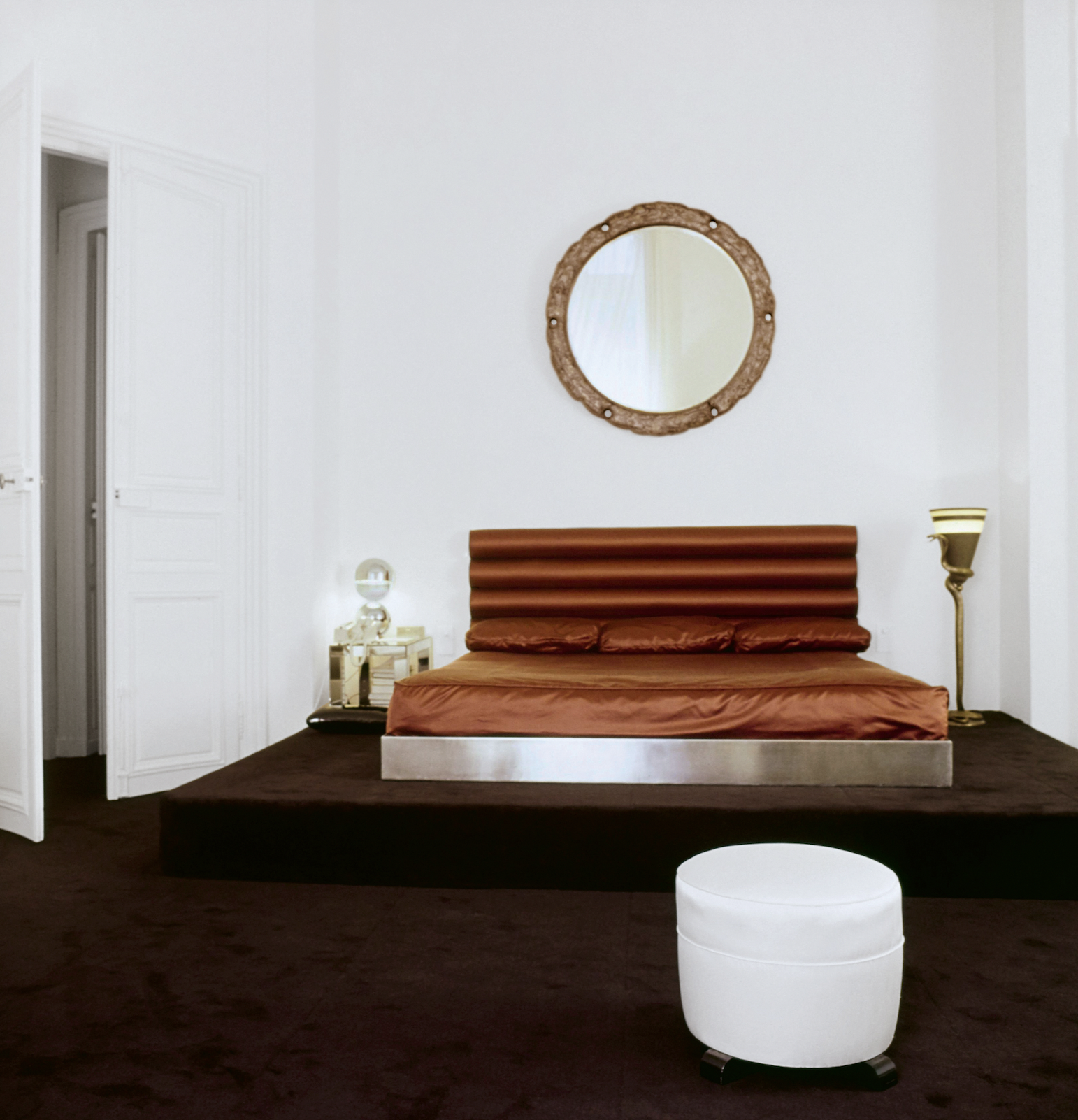
Lagerfeld died in 2019, and the process of dispersing his worldly goods is still ongoing. The Quái Voltaire apartment was sold this year for US$10.8 million (around $16.3 million). Now only the rue de Saint-Peres property remains within the Lagerfeld trust. Purchased after Quái Voltaire to further accommodate more of his books—35,000 were displayed in his studio alone, always stacked horizontally so he could read the titles without straining his neck—and as a place for food preparation as he loathed his primary living space having any trace of cooking smells. Today, the rue de Saint-Peres residence is open to the public as an arts performance space and most fittingly, a library.
You may also like.
By Josh Bozin
24/07/2024
Watch This Space: Mike Nouveau
Meet the game-changing horological influencers blazing a trail across social media—and doing things their own way.
In the thriving world of luxury watches, few people own a space that offers unfiltered digital amplification. And that’s precisely what makes the likes of Brynn Wallner, Teddy Baldassarre, Mike Nouveau and Justin Hast so compelling.
These thought-provoking digital crusaders are now paving the way for the story of watches to be told, and shown, in a new light. Speaking to thousands of followers on the daily—mainly via TikTok, Instagram and YouTube—these progressive commentators represent the new guard of watch pundits. And they’re swaying the opinions, and dollars, of the up-and-coming generations who now represent the target consumer of this booming sector.
—
MIKE NOUVEAU

Can we please see what’s on the wrist? That’s the question that catapulted Mike Nouveau into watch stardom, thanks to his penchant for highlighting incredibly rare timepieces across his TikTok account of more than 400,000 followers. When viewing Nouveau’s attention-grabbing video clips—usually shot in a New York City neighbourhood—it’s not uncommon to find him wrist-rolling some of the world’s rarest timepieces, like the million-dollar Cartier Cheich (a clip he posted in May).
But how did someone without any previous watch experience come to amass such a cult following, and in the process gain access to some of the world’s most coveted timepieces? Nouveau admits had been a collector for many years, but moved didn’t move into horology full-time until 2020, when he swapped his DJing career for one as a vintage watch specialist.
“I probably researched for a year before I even bought my first watch,” says Nouveau, alluding to his Rolex GMT Master “Pepsi” ref. 1675 from 1967, a lionised timepiece in the vintage cosmos. “I would see deals arise that I knew were very good, but they weren’t necessarily watches that I wanted to buy myself. I eventually started buying and selling, flipping just for fun because I knew how to spot a good deal.”
Nouveau claims that before launching his TikTok account in the wake of Covid-19, no one in the watch community knew he existed. “There really wasn’t much watch content, if any, on TikTok before I started posting, especially talking about vintage watches. There’s still not that many voices for vintage watches, period,” says Nouveau. “It just so happens that my audience probably skews younger, and I’d say there are just as many young people interested in vintage watches as there are in modern watches.”
View this post on Instagram
Nouveau recently posted a video to his TikTok account revealing that the average price of a watch purchased by Gen Z is now almost US$11,000 (around $16,500), with 41 percent of them coming into possession of a luxury watch in the past 12 months.
“Do as much independent research as you can [when buying],” he advises. “The more you do, the more informed you are and the less likely you are to make a mistake. And don’t bring modern watch expectations to the vintage world because it’s very different. People say, ‘buy the dealer’, but I don’t do that. I trust myself and myself only.”
—
Read more about the influencers shaking up horology here with Justin Hast, Brynn Wallner and Teddy Baldassare.
You may also like.
By Josh Bozin
24/07/2024
This Pristine 1960 Ferrari 250 Spider Could Fetch $24 Million at Auction
The car wears the same colours and has the same engine it left the factory with.
Some Ferraris are just a little bit more important than others.
Take, for example, the 1960 250 GT SWB California that RM Sotheby’s is auctioning off during this year’s Monterey Car Week. Any example of the open-top beauty would attract interest, but this one just so happens to be the first one that was built.
The 250 is one of the most legendary series of cars in Ferrari history. Between 1952 and 1964, the company released 21 different 250 models—seven for racetracks, 14 for public roads—of which the “Cali Spider” might be the most well regarded, thanks to its potent V-12 and a Pininfarina-penned design that is one of the most beautiful bodies to grace an automobile. The roadster, which was specifically built for the U.S., made its debut in 1957 as a long-wheel-base model (LWB), but it wasn’t until the SWB model debut in 1960 that it became clear how special it was. This example isn’t just the first to roll off the line. It’s the actual car that was used to introduce the world to the model at the 1960 Geneva Motor Show.

Just 56 examples of the 250 GT SWB California Spider would be built by Scaglietti during the three years it was in production. The first of those, chassis 1795 GT, is finished in a glossy coat of Grigio. The two-door had a red leather interior at Geneva but was returned to the factory and re-outfitted with black leather upholstery before being delivered to its original owner, British race car driver John Gordon Bennet. Six-and-a-half decades later the car looks identical to how it did when it left the factory the second time.
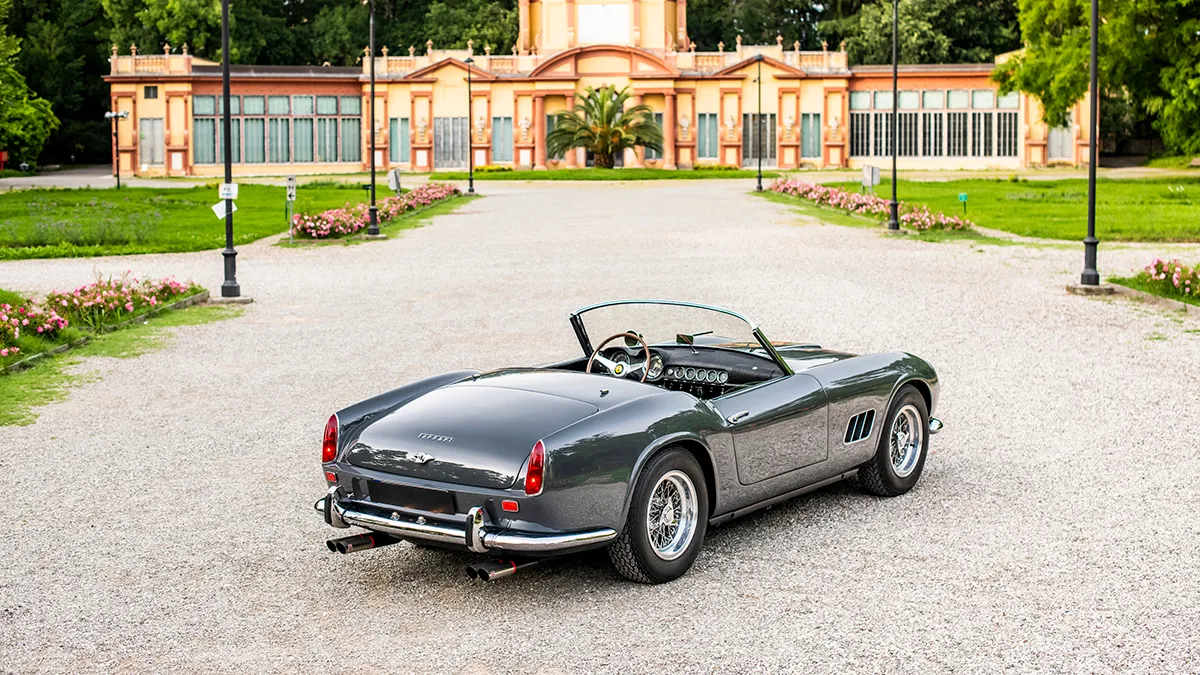
In addition to its original bodywork, the chassis 1795 GT features its original engine, gearbox, and rear axle. That mill is the competition-spec Tipo 168, a 3.0-litre V-12 that makes 196.1 kW. That may not sound like much by today’s standards, but, when you consider that the 250 GT SWB California Spider tips the scales around 952 kilograms, it’s more than enough.
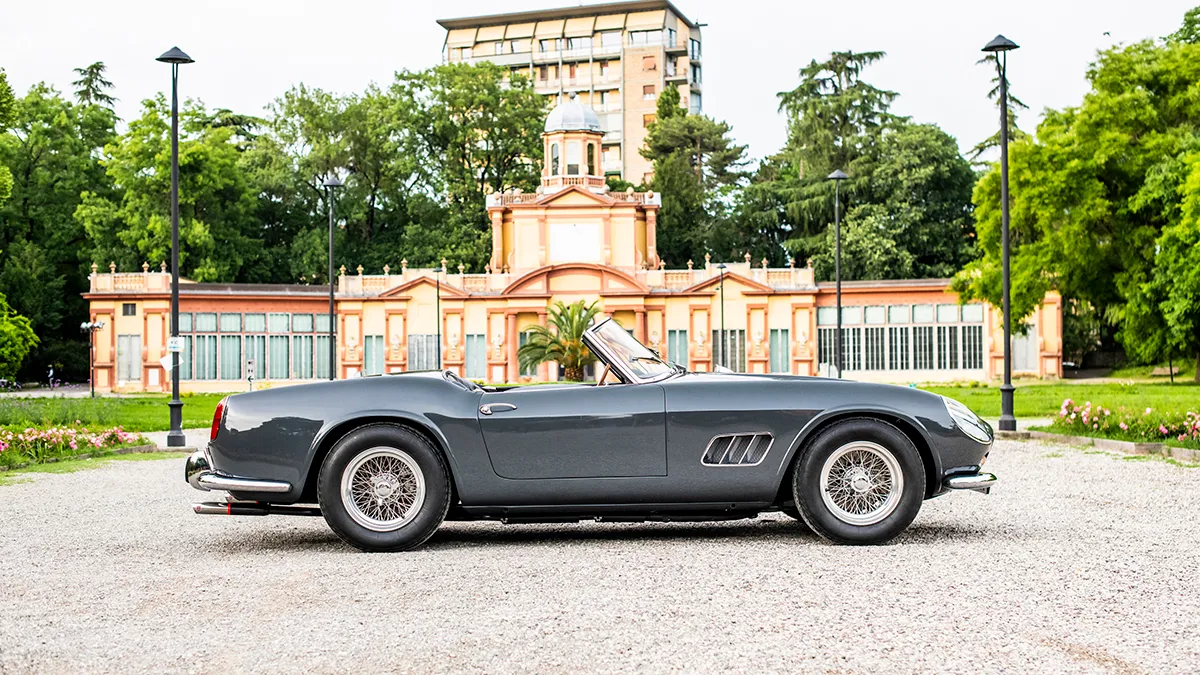
The first 250 GT SWB California Spider is scheduled to go up for bid during RM Sotheby’s annual Monterey Car Week auction, which runs from Thursday, August 15, to Saturday, August 17. Unsurprisingly, the house has quite high hopes for the car. The car carries an estimate of between $24 million and $26 million, which could make it one of the most expensive cars ever sold at auction.

You may also like.
By Josh Bozin
24/07/2024

















